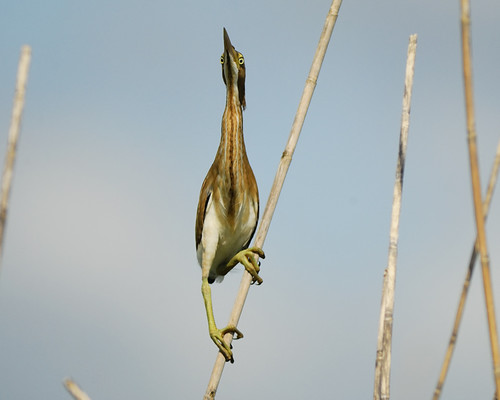tags: Least Bittern, North American Bittern, Ixobrychus exilis, birds, mystery bird, bird ID quiz
[Mystery bird] Least Bittern, Ixobrychus exilis, photographed at Anahuac National Wildlife Refuge, Anahuac, Texas. [I will identify this bird for you in 48 hours]
Image: Joseph Kennedy, 5 July 2010 [larger view].
Nikon D200, Kowa 883 telescope with TSN-PZ camera eyepiece 1/1250s f/8.0 at 1000.0mm iso400.
Please name at least one field mark that supports your identification.
Why are these bird's eyes placed in such a strange way on its head?
This bird's eyes are placed in a pointing down way so they can watch for prey (often fish) as they stand in the reeds by the water.
More like this
This is a summary of several of the better books I’ve had the opportunity to review here, organized in general categories.
tags: birds, mystery bird, bird ID quiz
tags: conservation, endangered species,
Family Guy, S07E02 'I Dream of Jesus':
Peter: Brian, can I see that paper for a sec?
(Brian gives Peter the paper. Peter peruses the paper.)
Peter: Huh... that's odd... I thought that would big news.


What a GREAT picture! I love the eyes, especially.
I'm guessing it's eyes have evolved to be where they are to provide good binocular vision below its chin for shaving in the morning.
Okay, not really. Good binocular vision for standing around very still with it's beak up so it's hard to see (and thus hard for predators to hunt and hard for prey species to stay away from) while being able to see well below so that it can spot an unwary fish (or frog or other?) below that it can quickly grab.
I think the "bold stripes" of the neck are supposed to be a big field mark. Of the two types found in the US, I think this is the larger.
I've said it before, often, you really take some great pictures Mr. Kennedy. Thanks, rb
At first glance, I thought "Bittern". (By which I meant of course the original and best, European Bittern.) I'll stick with that, but presumably it's the North American version.
Despite many holidays on the Norfolk Broads I've never seen or even heard a bittern. :-(
Bardiac, you might want to look closer -- I think the dark central throat stripe, the lack of a dark stripe below the eye to the base of the bill, and the white unstriped belly are problematic. I have some nice video of a Least Bittern from PA last year, but I don't have the time to check it out right now.
I'm going to go with the light, clear belly and the size of the bird vs. the reeds and assume the lesser of two North American bitterns.
I was once privileged to watch a small group of them skulking about an opening in the cattails early one morning. (So many years later, I can *still* hardly believe my luck.)
The larger bittern I've mostly just heard and very occasionally seen flying away.
How does Mr. Kennedy DO it !! I've only seen one (in the SW corner of AZ) of the smaller ones fly--and only because someone shouted: LEAST BITTERN!
Hi,
This photo is also at http://www.pbase.com/joseph_kennedy_36/image/126459465 where it is identified as a Least Bittern. That is what I pegged it as when I saw it on this site, as it has delicate proportions, is obviously small compared to the reed it perches on, and it has a white belly. The photo is one of a series of 25 photographs of Least Bittern.
*facepalm*
corrected, rob. sorry everyone.